sacred landscapes of india
pictures for Nama Rupa

Hampi sunrise
A few months ago I had a photo-essay published in the first issue of Nama Rupa. Nama Rupa is a project I feel very honoured and proud to be involved with - it’s a serious magazine about yoga and other systems of Indian philosophy. This page has everything I submitted, including text and pictures that they chose not to use. It’s an interesting experience submitting a portfolio to a photo editor who says “hey, these are great”, and then proceeds to use your least favourite pictures that you put in almost as filler, and not use your beloved masterpieces. I assume professionals get used to it. The text is more a series of extended picture captions than a coherent article.
northern karnataka
I spent a week staying in my friend Lakshmish’s home village in a remote and beautiful area of forest, hills and beaches in northern Karnataka. Apart from being introduced to Lakshmish’s family and friends - who were all hospitable and charming - our days consisted of a series of visits to temples, shrines and pilgrimage sites. Some, like a huge Shiva statue recently paid for by a devout ceramic tile millionaire on the coast at Murdeshwara, were well-known tourist destinations. Others were remote forest shrines and village temples. But big or small, famous or obscure, it is these sacred sites that define for Lakshmish the geography of his home turf.
Lakshmish comes from a Brahmin family and is a graduate student of Vedic philosophy at the Sanksrit College in Mysore (where Sri K. Pattabhi Jois used to teach) - so it isn’t exactly surprising that he should see his native landscape this way. But it’s not an unusual point of view. One day at Yana - a remote Shaivite shrine in the forest - we ran into a group of software engineers from Bangalore on a weekend excursion; I kind of expected that software engineers would be stereotypes of materialistic New India, blind to their country’s spiritual heritage. Far from it. Not only was their idea of a fun weekend road trip spending twelve hours overnight in a minibus and then trekking through the forest to visit a shrine, but when we got talking to them I also found out that one of them was seriously into vipassana meditation and a couple of others regularly went to yoga classes.
These pictures are actually from one of my few outings with Lakshmish that wasn’t to a temple - views from the hill behind his village. He’s fortunate to have grown up in such a beautiful place.

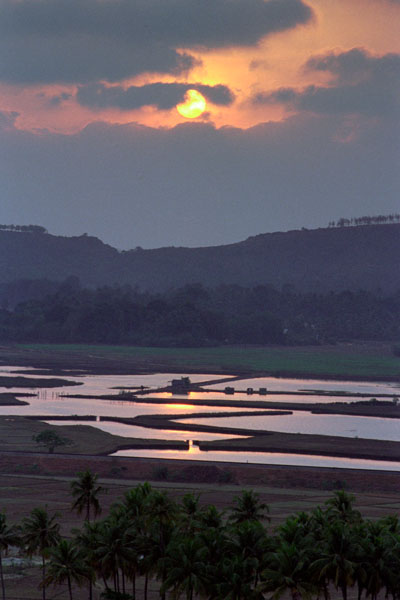
Karnataka coast sunset
yana
Yana is an important Shaivite pilgrimage site located in a remote part of the Western Ghats in northern Karnataka, where two huge and spectacular gothic rock spires, Shiva and Parvati, rise out of the forest. I haven’t seen it mentioned in any western guidebook - I insisted that Lakshmish take me there, after he’d shown me a picture of it in Mysore. It’s reached by a local bus ride for miles up a dirt road that looked like it would be ok in a four wheel drive but I wouldn’t have even considered trying to get a bus up there, followed by a couple of hours’ trek through the forest.

Parvati.
Nama Rupa used this one, even though I think the midday haze spoils it. There’s no guest house at Yana, and the bus times make it difficult for a visitor to be there for the morning or evening light unless you want to sleep out in a forest inhabited by leopards and huge cobras.

Inside Shiva
(it’s a pity this isn’t a great photo, because “inside Shiva” would be such a marvellous caption)
gokarna
I worry for Gokarna. It’s one of the most important Shaivite holy places in India. It’s also a favourite beach hangout for western travellers who find Goa too commercial and westernised. And the mix isn’t working well. Here’s what I had to say about it in my travel diary:
I like Gokarna - it’s a really charming little Karnataka country town that hasn’t (yet) been ruined by tourism. The town itself is old and quaint and fascinating. The coastline is spectacular, harsher and more interesting to look at than the endless coconut groves of Kerala, and some of the beaches are idyllic.
Some of them aren’t, though. Om Beach - famous traveller/beach party hang out - looks lovely from a distance but close up it’s dirty and unpleasant. A large proportion of the westerners here are scruffy, heavy drug users who dress and behave with no respect for local mores in what is, after all, one of the holiest Hindu pilgrimage sites in India. I’m not at all impressed. The drug scene isn’t just cannabis in all its many varieties, either - lots of acid, and ketamine seems to be very much in fashion. Ugh. I don’t even have the impression that locals are getting much financial benefit from the western tourism - the people making money are beach cafe proprietors and (presumably) drug dealers, and most of them seem to be northerners or Nepalis.

Locals & pilgrims bathing in the temple tank at Gokarna shortly before the Maha Shivaratri festival, March 2002, from Ganesha temple doorway
This was on the Nama Rupa website but not in the magazine.
All the temples in Gokarna have signs banning foreigners. This is common in Kerala, but Gokarna is the only place I have seen it in the state of Karnataka. Everywhere else I went in the state, including other pilgrimage sites not far from Gokarna, I was welcomed into temples and nobody assumed that as a foreign visitor I couldn’t be counted on to dress and behave respectfully. It hasn’t always been this way in Gokarna either - a Canadian friend of mine told me she was there twenty years ago for Maha Shivaratri with her husband and newborn baby, and was allowed into the inner shrine where the holy Shiva Lingam is along with all the other pilgrims. The sad thing is, given the dress and behaviour of a lot of the westerners in Gokarna today, I can see why people would think it was necessary to ban them.
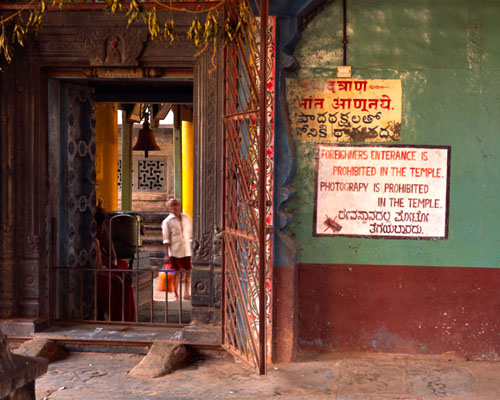
Foreigners prohibited in the temple that houses the famous Shiva Lingam.
Nama Rupa used this one for the editorial - a nice touch for the inaugural issue of a magazine about Indian philosophy based in New York and aimed at westerners.
It is still a beautiful place, though. It’s great to get up before the other tourists and go and wander around the old part of town at dawn, watching the pilgrims bathing in the temple tank and the cows wandering in and out of the houses.
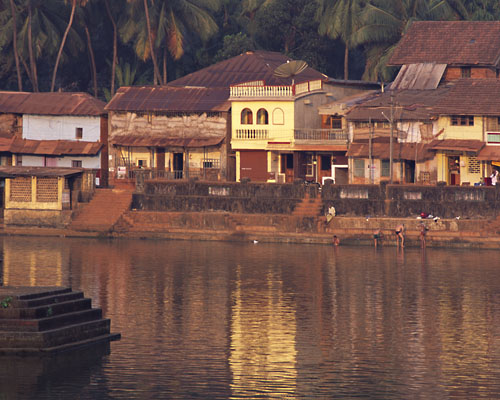
Another view of Gokarna temple tank.
This looked great as a double-page sread.
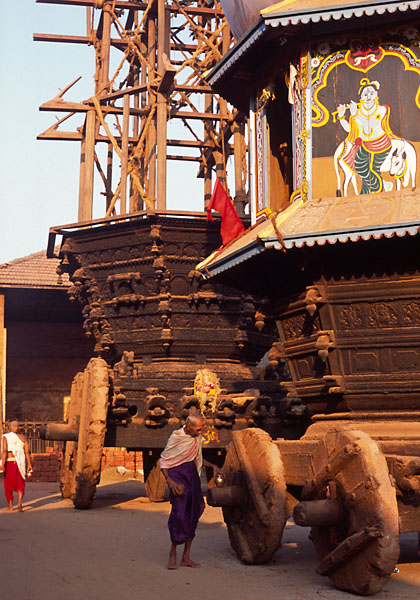
Temple chariots being prepared for the Maha Shivaratri festival, Gokarna.
This one was used as the endpiece for an article on Patanjali’s Yoga Sutras by Edwin Bryant, whose excellent book The Quest for the Origins of Vedic Culture I also highly recommend.
hampi
Hampi - a small village that is all that remains of the former city of Vijayanagar - is probably southern India’s most famous tourist attraction, and it’s a fascinating place. Five hundred years ago Vijayanagar was the capital of a Hindu kingdom that held out in the south against Muslim invaders, and was described by travellers as the most impressive city in India, if not the world. Apart from a couple of scruffy little villages, all that’s left now is miles and miles of amazing boulder-strewn granite hills dotted with literally hundreds of ruined temples, some of them very impressive indeed. I think about how strange it is that people chose to put a city here, in this beautiful but harsh and weird landscape. About what kind of mentality would produce a civilization that leaves behind hundreds of superbly crafted carved granite temples, but whose dwellings were so flimsy that hardly a trace of them remains?
One of the most spectacular pictures I had seen of Hampi was a view from Matunga Hill at dawn. Matunga Hill is right in the middle of the ruins, overlooking the east end of Hampi village - the photo I had seen was taken from the roof of the temple on the summit, looking almost directly down into the Achutarya temple complex at the foot of the hill. So I duly got up at four o’clock one morning (an ordeal I thought I had put behind me when I left Pattabhi Jois’s yoga school in Mysore) and managed to find my way up the hill by moonlight. I didn’t get the photo I had set out to copy - the light was wrong, and the Achutarya temple was full of trucks and lighting rigs for a Kate Winslett movie that was being filmed there. So I had to find my own photos instead - I was busy taking a series of wide angle panoramas, when I noticed the rising sun reflecting on a small pond in the distance. Landscape photographers have to work quickly in India, the interesting light at dawn and sunset only lasts a few minutes. A quick switch to a telephoto lens before the light changed, and this was the result:
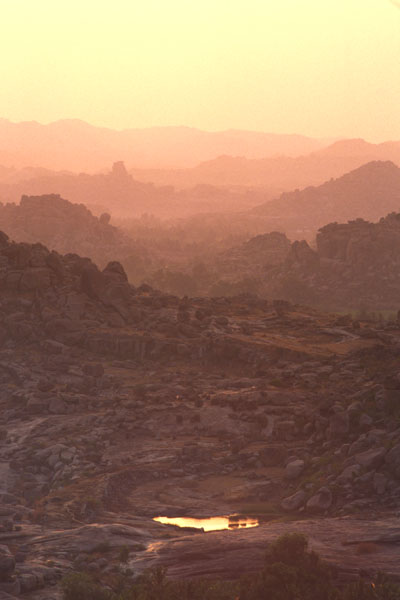
“I do not think there is a more interesting or beautiful view than this, in the whole of Southern India”
A.H. Longhurst, Hampi Ruins Described and Illustrated (1917)

Another view from Matunga Hill, looking south from the roof of the ruined temple on the summit.
This one was a double page spread in the magazine, and looked great.
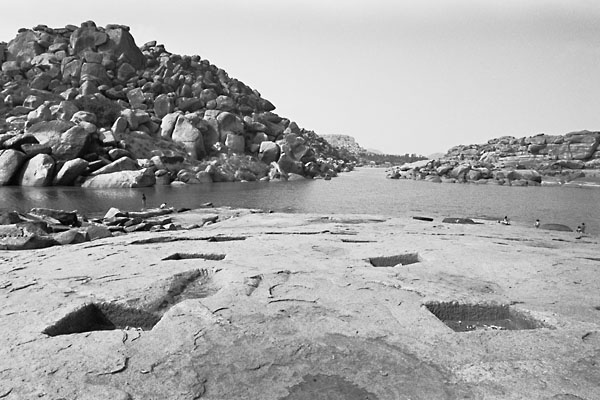
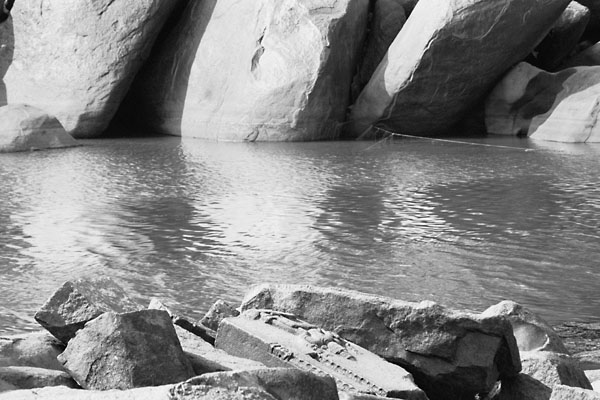
Tungabadra River
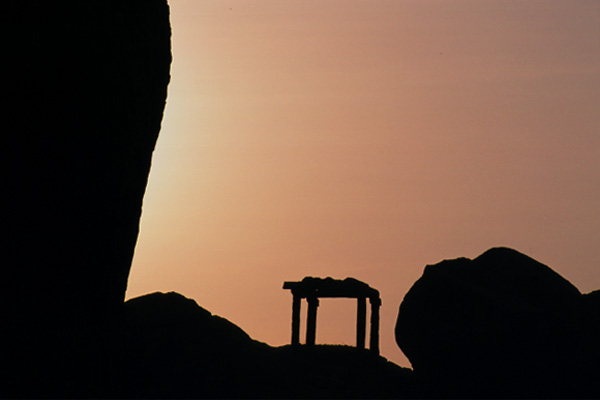
Another Hampi sunrise
Vijayanagar is in ruins - only one of its great temples is still in use. The dynasty before Vijayanagar, the Hoysalas, built temples that were even more beautiful, but only one of the “big three” Hoysala temples, at Belur, is still partly in use as a place of worship. Kings and kingdoms and their great temples come and go; it is village India with its little shrines and holy places that endures.
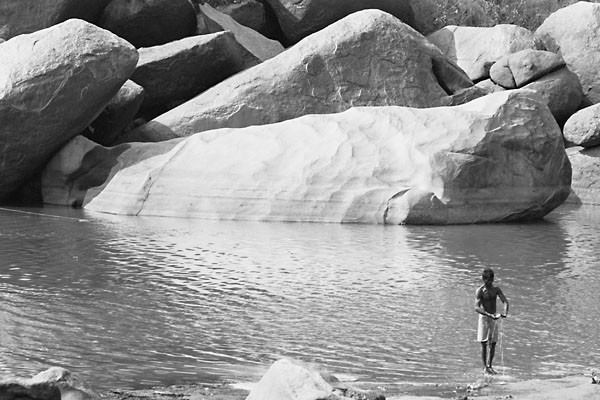
A Hampi villager washes clothes in the Tungabadra river, formerly the northen boundary of the imperial capital city Vijayanagar.
Nama Rupa used this one
around mysore
Small roadside and riverside shrines are everywhere. One day I set out from Mysore by motorbike to meet up with friends at the Hoysala temple at Somnathpur - one of India’s World Heritage sites, famous for its intricate and beautiful thirteenth century sculpture. Being only a couple of hours’ drive from Mysore, it’s a popular spot for clichéd yoga-asana-in-front-of-temple photos - I had already taken a couple of rolls of those on a previous visit. This time, though, I started taking pictures at a small Shiva temple on the outskirts of Mysore, then at a roadside farmer’s market at the foot of Chaumundi Hill, then shot a couple of rolls of roadside scenes on the way out of town. Much film later I arrived at the small town of T. Narsipur, where the confluence of two rivers a few miles outside Mysore is surrounded by temples, ghats and small riverside shrines - all very photogenic. I didn’t make it to Somnathpur, but I had a lot of fun and got some of my best photos of India - far better than the many rolls of films I shot at famous tourist sites.
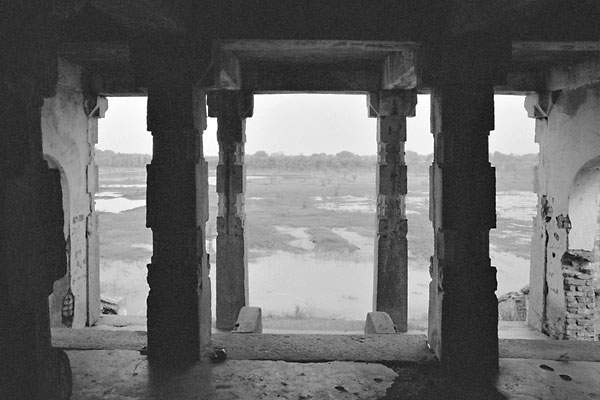
Roadside shrine between Mysore and T. Narsipur
… and this one
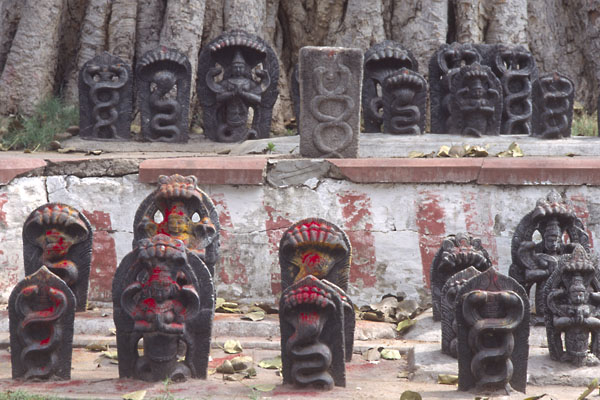
Riverside shrine at ghats, Srirangapatna
… and this one
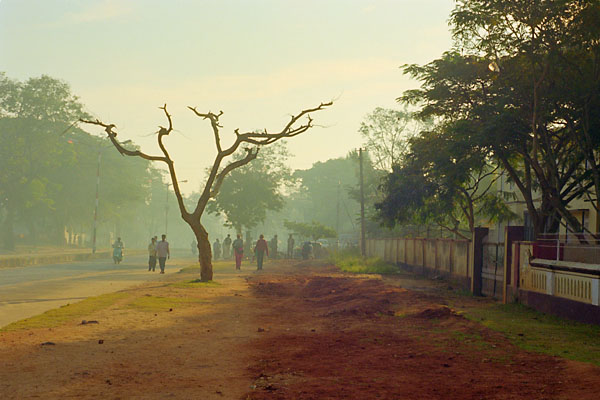
After the morning yoga class, Mysore

Chaumundi Hill, Mysore

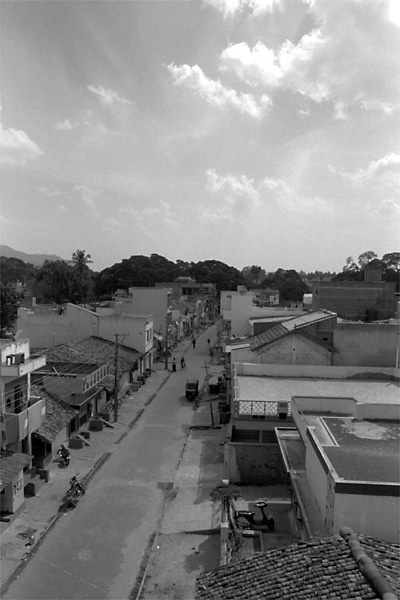
Views of Chaumundi Hill from Mysore
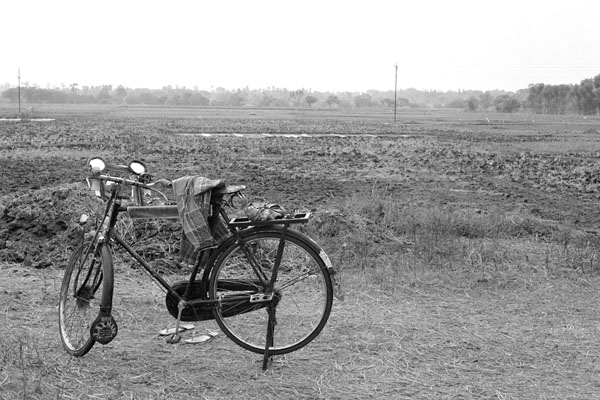
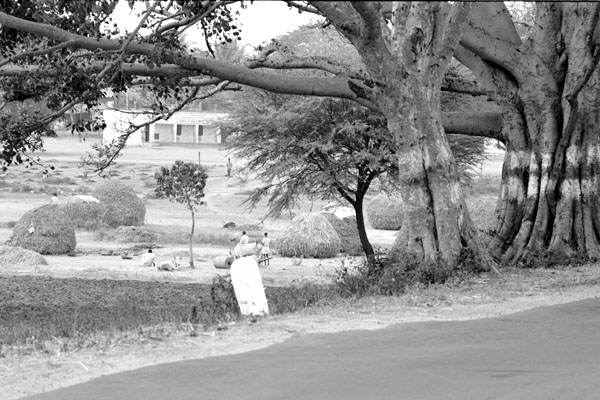
Roadside scenes near Mysore

The Nilgiri Hills, Ooty, Tamil Nadu. The Nilgiris are the highest mountains in southern India, and Ooty was one of the original British “hill stations” - a resort in the mountains where the servants of the Raj would go in summer to get away from the heat of the lowlands. I took this picture in the grounds of the former Maharajah of Mysore’s summer palace at Fern Hill, which is currently in the process of being refurbished as a five star hotel - a room with a view.
kerala
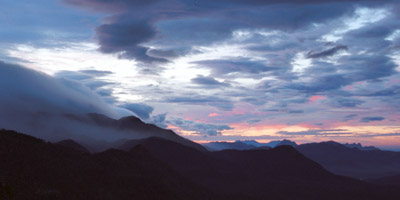

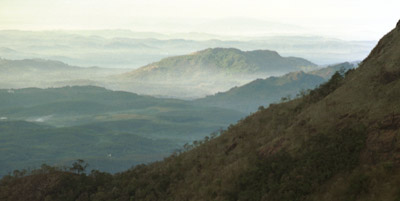
Sunrise, Cardamom Hills, Kerala.
These are some older pictures from my first visit to india. I didn't have time to work up decent-looking larger versions for the magazine submission - which is a pity, because I’m fond of them.

Kovalam - the endless coconut groves of Kerala
about the author
Alan Little has studied ashtanga vinyasa yoga since 1996, and has made two trips to India to study yoga - in Kerala with Lino Miele in 1999-2000, and in Mysore with Pattabhi Jois in 2001-2. Alan is an expatriate Englishman living in Munich, Germany with his girlfriend Maria. They are expecting their first child. He funds his yoga studies and photography with a day job as a software developer. His online diary from his second trip to India is at http://www.alanlittle.org/yoga/MysoreDiary.html, and more of his pictures of India are at http://www.alanlittle.org/gallery/India
text & photos © 2000 to 2003